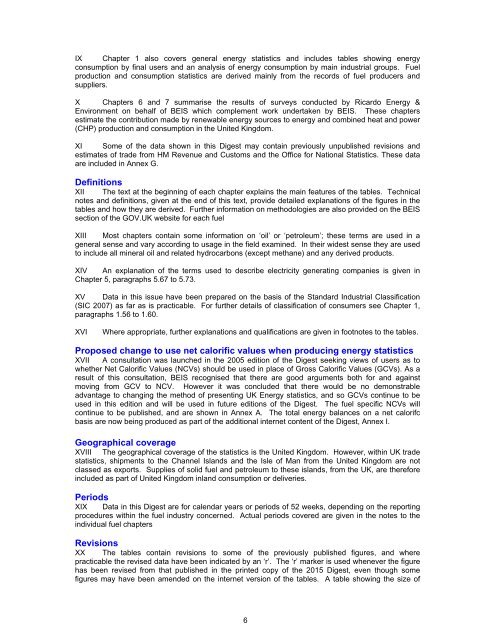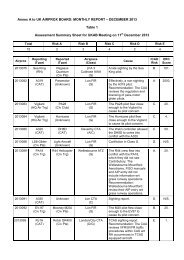STATISTICS 2016
DUKES_2016_FINAL
DUKES_2016_FINAL
Create successful ePaper yourself
Turn your PDF publications into a flip-book with our unique Google optimized e-Paper software.
IX Chapter 1 also covers general energy statistics and includes tables showing energy<br />
consumption by final users and an analysis of energy consumption by main industrial groups. Fuel<br />
production and consumption statistics are derived mainly from the records of fuel producers and<br />
suppliers.<br />
X Chapters 6 and 7 summarise the results of surveys conducted by Ricardo Energy &<br />
Environment on behalf of BEIS which complement work undertaken by BEIS. These chapters<br />
estimate the contribution made by renewable energy sources to energy and combined heat and power<br />
(CHP) production and consumption in the United Kingdom.<br />
XI Some of the data shown in this Digest may contain previously unpublished revisions and<br />
estimates of trade from HM Revenue and Customs and the Office for National Statistics. These data<br />
are included in Annex G.<br />
Definitions<br />
XII The text at the beginning of each chapter explains the main features of the tables. Technical<br />
notes and definitions, given at the end of this text, provide detailed explanations of the figures in the<br />
tables and how they are derived. Further information on methodologies are also provided on the BEIS<br />
section of the GOV.UK website for each fuel<br />
XIII Most chapters contain some information on ‘oil’ or ‘petroleum’; these terms are used in a<br />
general sense and vary according to usage in the field examined. In their widest sense they are used<br />
to include all mineral oil and related hydrocarbons (except methane) and any derived products.<br />
XIV An explanation of the terms used to describe electricity generating companies is given in<br />
Chapter 5, paragraphs 5.67 to 5.73.<br />
XV Data in this issue have been prepared on the basis of the Standard Industrial Classification<br />
(SIC 2007) as far as is practicable. For further details of classification of consumers see Chapter 1,<br />
paragraphs 1.56 to 1.60.<br />
XVI<br />
Where appropriate, further explanations and qualifications are given in footnotes to the tables.<br />
Proposed change to use net calorific values when producing energy statistics<br />
XVII A consultation was launched in the 2005 edition of the Digest seeking views of users as to<br />
whether Net Calorific Values (NCVs) should be used in place of Gross Calorific Values (GCVs). As a<br />
result of this consultation, BEIS recognised that there are good arguments both for and against<br />
moving from GCV to NCV. However it was concluded that there would be no demonstrable<br />
advantage to changing the method of presenting UK Energy statistics, and so GCVs continue to be<br />
used in this edition and will be used in future editions of the Digest. The fuel specific NCVs will<br />
continue to be published, and are shown in Annex A. The total energy balances on a net calorifc<br />
basis are now being produced as part of the additional internet content of the Digest, Annex I.<br />
Geographical coverage<br />
XVIII The geographical coverage of the statistics is the United Kingdom. However, within UK trade<br />
statistics, shipments to the Channel Islands and the Isle of Man from the United Kingdom are not<br />
classed as exports. Supplies of solid fuel and petroleum to these islands, from the UK, are therefore<br />
included as part of United Kingdom inland consumption or deliveries.<br />
Periods<br />
XIX Data in this Digest are for calendar years or periods of 52 weeks, depending on the reporting<br />
procedures within the fuel industry concerned. Actual periods covered are given in the notes to the<br />
individual fuel chapters<br />
Revisions<br />
XX The tables contain revisions to some of the previously published figures, and where<br />
practicable the revised data have been indicated by an ‘r’. The ‘r’ marker is used whenever the figure<br />
has been revised from that published in the printed copy of the 2015 Digest, even though some<br />
figures may have been amended on the internet version of the tables. A table showing the size of<br />
6







